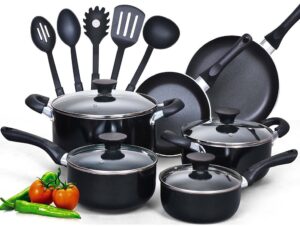Your ultimate digital companion
Your ultimate digital companion

1. Easy to Use: Non-stick cookware lives up to its name by preventing food from sticking to its surface. This makes cooking delicate items like eggs and fish a breeze, without needing a lot of oil or butter.
2. Effortless Cleaning: Say goodbye to endless scrubbing. Non-stick surfaces wipe clean with little to no effort, saving time and elbow grease.
3. Health Benefits: With proper care, non-stick cookware can help you cook healthier meals. You can reduce the need for excess fats, promoting lighter and more nutritious cooking.
4. Affordable: Non-stick cookware comes in a range of prices, making it accessible to most households. Whether you’re on a budget or looking for high-end options, there’s something for everyone.
1. Durability Concerns: Traditional non-stick coatings can degrade over time, especially when exposed to high temperatures or harsh cleaning methods. This can lead to peeling or flaking, making the cookware less effective and potentially exposing users to harmful chemicals.
2. Health Risks: There’s concern about a chemical called perfluorooctanoic acid (PFOA), which used to be part of the production process. While many manufacturers have phased out PFOA, some worry remains about the potential health effects of other chemicals used in non-stick coatings, especially when heated to high temperatures.
3. Environmental Impact: The production and disposal of non-stick cookware raise environmental concerns. Traditional non-stick coatings are not biodegradable and can release harmful compounds if incinerated. Additionally, mining materials used in non-stick coatings, such as polytetrafluoroethylene (PTFE), can have ecological repercussions.
4. Limited Versatility: While great for certain types of cooking, non-stick cookware may not be suitable for all culinary tasks. High-heat searing or broiling, for example, can damage non-stick coatings, limiting their versatility in the kitchen.
1. Stay Informed: Keep up to date with the latest advancements in non-stick technology and materials. Look for cookware brands that prioritize safety, durability, and sustainability.
2. Use with Care: Extend the lifespan of your non-stick cookware by using it properly. Avoid using metal utensils, high heat settings, and harsh cleaning agents that can damage the coating.
3. Consider Alternatives: Explore other cookware materials such as stainless steel, cast iron, or ceramic, each with their own benefits and drawbacks. Mix and match to suit your cooking preferences and needs.
4. Responsible Disposal: When it’s time to get rid of your non-stick cookware, dispose of it responsibly. Check with local recycling programs for guidance on how to properly recycle or dispose of non-stick pans.
In conclusion, the debate over non-stick cookware is complex, with both advantages and drawbacks to consider. While its convenience is undeniable, it’s important to weigh the potential health and environmental impacts